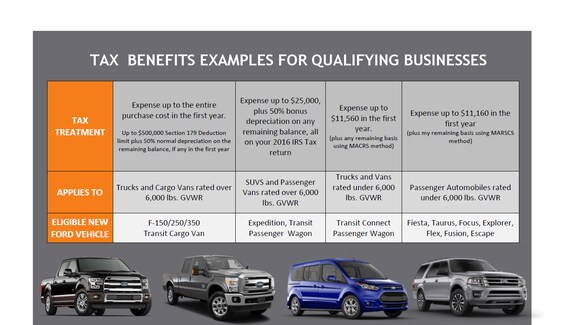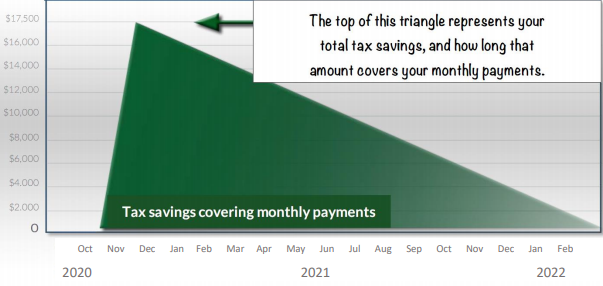
According to the irs, the maximum tax break that you will receive for placing a “heavy” vehicle in use will be $25,000. If the vehicle is not used 100% of the time for business, the deduction allowance is reduced proportionately.

What vehicles qualify for the full section 179 deduction in 2020?
Tax deductions for vehicles under 6000 lbs. To qualify as a “heavy” vehicle, an suv, pickup or van must have a manufacturer�s gross vehicle weight rating (gvwr) above 6,000 pounds. If you purchase a vehicle over 6,000 lbs, you can circumvent this ceiling and claim the full amount of bonus depreciation or section 179 on your vehicle. The vehicle purchased must weigh over 6,000 pounds, according to the gross vehicle weight rating (gvwr), but no more than 14,000 pounds.
Also, there are top end deductions for different classes of vehicles. According to the irs, the maximum tax break that you will receive for placing a heavy vehicle in use will be $25,000. Ad turbotax® makes it easy to get your taxes done right.
According to the irs, the maximum tax break that you will receive for placing a “heavy” vehicle in use will be $25,000. These include passenger cars, crossovers, and small utility trucks. Passenger automobiles as defined under the internal revenue code (including sport utility vehicles, trucks and crossovers with a gvwr of 6,000 lbs.
If you can’t or don’t want to deduct based on mileage, you can deduct based on cost of operating the vehicle. If the vehicle is not used 100% of the time for business, the deduction allowance is reduced proportionately. The section 179 deduction and bonus deprecation deals are only available for an suv, pickup, or van with a manufacturer’s gross vehicle weight rating (gvwr) above 6,000 pounds that is purchased (not leased).
Gross vehicle weight can qualify for at least a partial section 179 deduction, plus bonus depreciation. Small vehicles that weigh under 6,000 pounds have a section 179 deduction limit of $10,100 in the first year they are used and $18,100 with bonus depreciation. Delivery type vehicles such as classic cargo vans or box trucks with no passenger seating.
This is key because the more your vehicle weighs, the more you. It’s easy to find attractive vehicles with gvwrs above the magic 6,000 pound threshold. The vehicle purchased must weigh over 6,000 pounds, according to the gross vehicle weight rating (gvwr), but no more than 14,000 pounds.
Or less) and placed in service during 2021 qualify for immediate depreciation deductions of up to $18,200 per vehicle. Trucks and vans that are considered passenger vehicles, rated under 6,000 lbs. If you are looking to write off the entire purchase price of g wagon, look into bonus depreciation rules that were passed under tcja.
Gross vehicle weight can qualify for at least partial section 179 deduction and bonus depreciation. And that weight needs to be gvwr or gross vehicle weight rating, which is the max loaded weight of. Internal revenue code, section 179 deduction allows you to expense up to $25,000 on vehicles (one year) that are between 6000 pounds and 14,000 pounds or more in the year they are placed in service.
To meet the weight criteria of section 179, the manufacturer’s gross vehicle weight rating (gvwr) must be greater than 6,000lbs. As a general rule, purchasing a 6,000 pound vehicle may help you qualify for up to $25,000 in deductions. What vehicles qualify for the full section 179 deduction in 2020?
Vehicles that can be written off for business include: Now the one stipulation for taking accelerated depreciation on the vehicle tax deduction is that the vehicle must weigh over 6,000 pounds. Answer simple questions about your life and we do the rest.
• obvious “work” vehicles that have no potential for personal use typically qualify. Gvwr, are limited to $18,000 of depreciation in the year of purchase with normal macrs depreciation on the remaining basis in the vehicle in subsequent years. Other vehicles can also qualify for valuable tax savings through section 179.
For example, small cars under 6,000 lbs., luxury autos, are capped at $18,000 of depreciation in the first year, $10,000 if bonus deprecation is not taken due to luxury auto limitations, the irs has imposed to help discourage the depreciation of high value vehicles. To qualify as a “heavy” vehicle, an suv, pickup or van must have a manufacturer’s gross vehicle weight rating (gvwr) above 6,000 pounds.